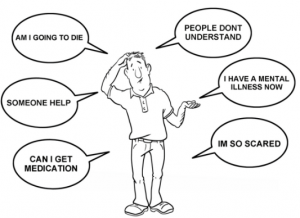OCD Foundation’s Annual Conference
 I recently attended the 21st annual OCD Conference in Los Angeles put on by the International OCD Foundation. The conference was well organized and had a wide variety of session topics from highly respected speakers in the field of OCD and OCD spectrum disorders with respect to research and treatment. By OCD spectrum, I’m referring to issues such as Trichotillomania, Body Dysmorphic Disorder, Hoarding, and Tourette’s Disorder. One aspect of this conference I appreciated was that attendees were not just treatment professionals, but included children, teens and adults with OCD, parents of children with OCD looking for support, and researchers. Not surprisingly, the overwhelming majority of treatment discussions focused on Exposure and Response Prevention (ERP). ERP is the gold standard for treatment of OCD for all age groups. ERP involves identifying the underlying obsession(s), illuminating the patterns of being triggered and engaging in compulsions, developing a fear hierarchy and finally defining response prevention guidelines.
I recently attended the 21st annual OCD Conference in Los Angeles put on by the International OCD Foundation. The conference was well organized and had a wide variety of session topics from highly respected speakers in the field of OCD and OCD spectrum disorders with respect to research and treatment. By OCD spectrum, I’m referring to issues such as Trichotillomania, Body Dysmorphic Disorder, Hoarding, and Tourette’s Disorder. One aspect of this conference I appreciated was that attendees were not just treatment professionals, but included children, teens and adults with OCD, parents of children with OCD looking for support, and researchers. Not surprisingly, the overwhelming majority of treatment discussions focused on Exposure and Response Prevention (ERP). ERP is the gold standard for treatment of OCD for all age groups. ERP involves identifying the underlying obsession(s), illuminating the patterns of being triggered and engaging in compulsions, developing a fear hierarchy and finally defining response prevention guidelines.
OCD Treatment with Children and Teens
Because I enjoy working with children and have a number of children with OCD on my caseload at any given time, I attended several talks geared toward OCD treatment for children and teens. A few of these were intended for children with OCD and others had content intended for treatment professionals. One of the talks I attended was about developing an effective toolbox for beating OCD, geared toward children with the disorder. One of the tools imparted on the attendees was knowledge about the adaptive nature of anxiety; for instance, when your heart races, it’s the body’s way of pumping blood to your muscles faster to help with fight or flight actions; when your body sweats, it’s so the body is slick if an attacker grabs onto you. So reduction in fear of anxiety itself can be a good first step. Another tool they wanted to arm attendees with was knowledge and experience with ERP. They helped the kids in the audience identify which type of OCD thoughts they had and as a group, we brainstormed ways to engage in exposures by figuring out how to test contamination fears, for instance, by exposure to different things in the meeting room we were in.
Using Mobile Apps for OCD
 Another session I attended was geared toward mobile applications that can help kids and teens develop exposures using cell phones and tablets. One of the applications that was highlighted turns spoken fears into songs that the child or teen can listen back to as exposure homework. The goal of this application is to turn a fear into something slightly comical or entertaining through song and music. By creating a competing reaction, like laughter, the fear diminishes because it’s fairly difficult to be entertained and laughing while also being fearful or scared. A second mobile application discussed in the presentation is useful with fears of harming others. The essential feature of this application allows users to create characters based on people they fear harming, and then allows them to virtually kill these people through the application. In essence, the user is acting out the feared behavior in a virtual world while still eliciting the anxiety. Both applications are useful in situations where an in vivo exposure is either not appropriate or difficult to execute.
Another session I attended was geared toward mobile applications that can help kids and teens develop exposures using cell phones and tablets. One of the applications that was highlighted turns spoken fears into songs that the child or teen can listen back to as exposure homework. The goal of this application is to turn a fear into something slightly comical or entertaining through song and music. By creating a competing reaction, like laughter, the fear diminishes because it’s fairly difficult to be entertained and laughing while also being fearful or scared. A second mobile application discussed in the presentation is useful with fears of harming others. The essential feature of this application allows users to create characters based on people they fear harming, and then allows them to virtually kill these people through the application. In essence, the user is acting out the feared behavior in a virtual world while still eliciting the anxiety. Both applications are useful in situations where an in vivo exposure is either not appropriate or difficult to execute.
Insight Helps with Beating OCD
Insight is a valuable tool in therapy. Research indicates that lack of insight with OCD is associated with greater symptom severity and higher risk for co-morbidity, or an additional diagnosis or clinical issue. I attended a panel discussion that focused on the role insight in the treatment of OCD and BDD among others disorders. Insight is not fixed and can be encouraged and modeled through the therapeutic process. Overvalued ideation was another concept tossed around that looks similar to insight but refers to the strength of conviction about a belief. Without insight, it’s difficult for someone dealing with OCD to entertain the idea that the rituals aren’t accurate. Lastly, the panel mentioned that when insight is low and progress is difficult to come by, psychopharmacological options can be helpful.
Health Anxiety Sub-Types
 There is a fair amount of overlap between health-related OCD and Somatic Symptom Disorder (SSD), formerly known as Hypochondriasis. Similar features include having thoughts about an illness, repeated self-checking, reassurance seeking with medical tests, doubting test results, and over-concern with the significance of bodily sensations. One of the main differences between the two is that with SSD, sufferers frequently experience visceral physical sensations, whereas OCD sufferers experience doubtful dysperceptions. It can be useful to think of health-related OCD and SSD on a continuum of doubt with OCD sufferers having considerable doubt and SSD sufferers having much less doubt. Exposure and Response Prevention can be an effective intervention with SSD as well OCD.
There is a fair amount of overlap between health-related OCD and Somatic Symptom Disorder (SSD), formerly known as Hypochondriasis. Similar features include having thoughts about an illness, repeated self-checking, reassurance seeking with medical tests, doubting test results, and over-concern with the significance of bodily sensations. One of the main differences between the two is that with SSD, sufferers frequently experience visceral physical sensations, whereas OCD sufferers experience doubtful dysperceptions. It can be useful to think of health-related OCD and SSD on a continuum of doubt with OCD sufferers having considerable doubt and SSD sufferers having much less doubt. Exposure and Response Prevention can be an effective intervention with SSD as well OCD.
Another concept mentioned in the SSD vs. health-related OCD presentation was iCompulsions or CyberChondriasis, which both relate to the act of mining websites like WebMD for health and treatment information as a form of reassurance-seeking. This behavior typically results in an increase in anxiety from increased focus on the physical sensation or discomfort. This can quite easily lead to catastrophizing thoughts about what a possible diagnosis might be. Even for individuals without SSD or OCD, seeking health information online can be a confusing, scary and misleading process. So combined with a hyperfocus on physical symptoms and/or persistent doubt, it’s understandable to see how SSD and OCD can develop.
Face Your Fears!
And lastly, a quote that was provided during the conference that I think gets at the heart of ERP is as follows: “Do the thing you fear the most, and it will be the certain death of it,” attributed to Ralph Waldo Emerson.


